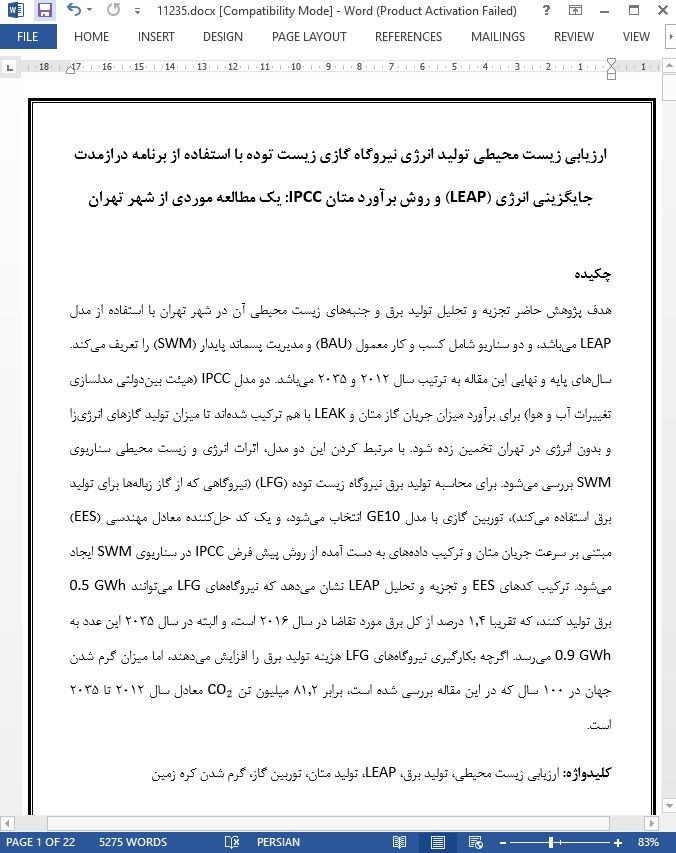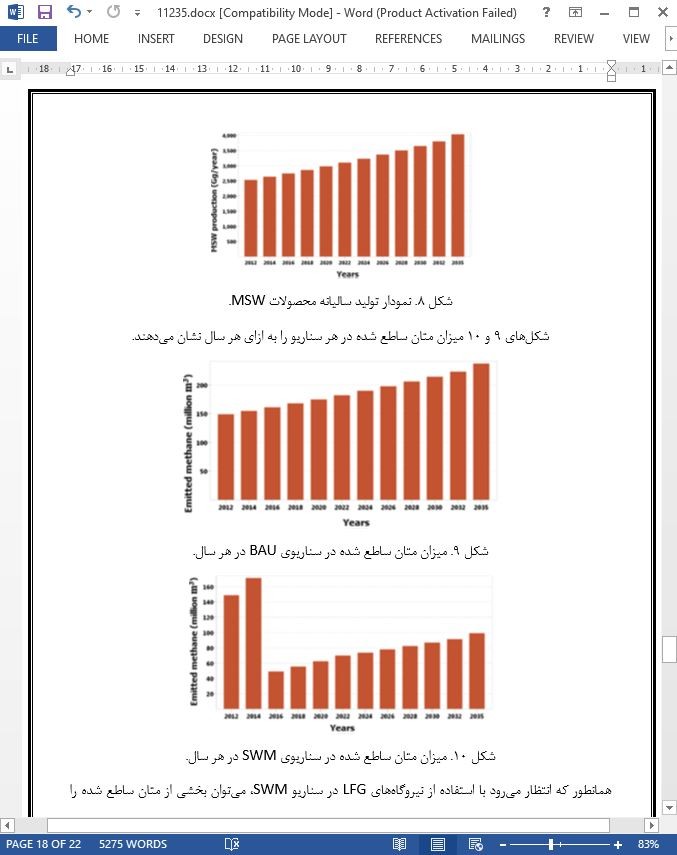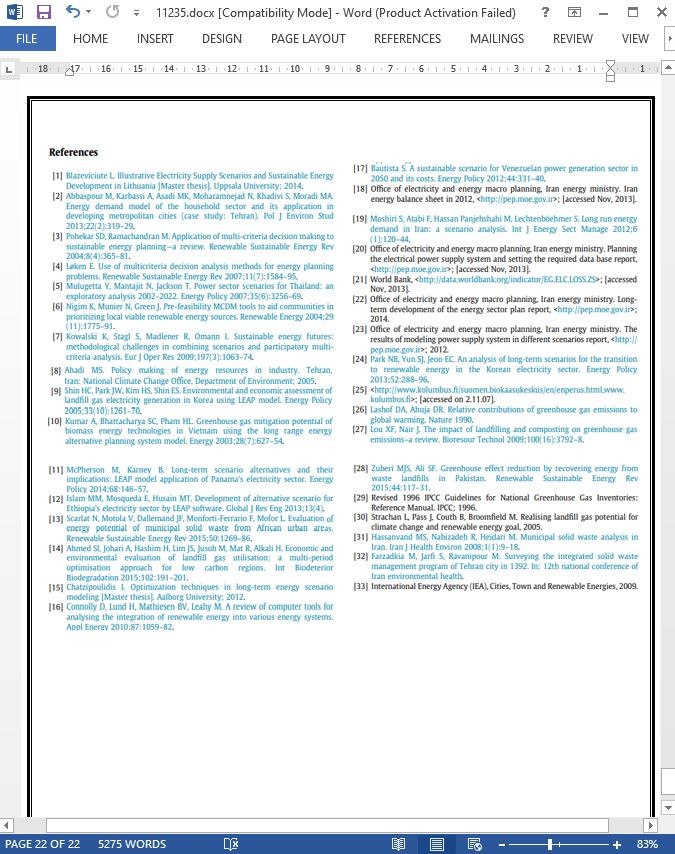
ارزیابی زیست محیطی تولید انرژی نیروگاه گازی زیست توده و روش برآورد متان IPCC
چکیده
هدف پژوهش حاضر تجزیه و تحلیل تولید برق و جنبه های زیست محیطی آن در شهر تهران با استفاده از مدل LEAP می باشد، و دو سناریو شامل کسب و کار معمول (BAU) و مدیریت پسماند پایدار (SWM) را تعریف می کند. سال های پایه و نهایی این مقاله به ترتیب سال 2012 و 2035 می باشد. دو مدل IPCC (هیئت بین دولتی مدلسازی تغییرات آب و هوا) برای برآورد میزان جریان گاز متان و LEAK با هم ترکیب شده اند تا میزان تولید گازهای انرژی زا و بدون انرژی در تهران تخمین زده شود. با مرتبط کردن این دو مدل، اثرات انرژی و زیست محیطی سناریوی SWM بررسی می شود. برای محاسبه تولید برق نیروگاه زیست توده (LFG) (نیروگاهی که از گاز زباله ها برای تولید برق استفاده می کند)، توربین گازی با مدل GE10 انتخاب می شود، و یک کد حل کننده معادل مهندسی (EES) مبتنی بر سرعت جریان متان و ترکیب داده های به دست آمده از روش پیش فرض IPCC در سناریوی SWM ایجاد می شود. ترکیب کدهای EES و تجزیه و تحلیل LEAP نشان می دهد که نیروگاههای LFG می توانند 0.5 GWh برق تولید کنند، که تقریبا 1.4 درصد از کل برق مورد تقاضا در سال 2016 است، و البته در سال 2035 این عدد به 0.9 GWh می رسد. اگرچه بکارگیری نیروگاههای LFG هزینه تولید برق را افزایش می دهند، اما میزان گرم شدن جهان در 100 سال که در این مقاله بررسی شده است، برابر 81.2 میلیون تن CO_2 معادل سال 2012 تا 2035 است.
مقدمه
امروزه در سراسر جهان تولید برق مورد نیاز صنعت به طور قابل توجهی به نفت وابسته است و جایگزینی منابع دیگر به جای این طلای سیاه در یک دوره کوتاه مدت غیر ممکن است. در نتیجه، با توجه به وجود تقاضای بسیار زیاد در زمینه انرژی، مشکلات زیست محیطی تبدیل به یکی از نگرانی های مهم بشر شده است. بنابراین ضرورت حرکت به سمت عدم وابستگی به نفت و یا حداقل کاهش این وابستگی در نزدیکترین زمان ممکن یک ضرورت است.
منابع نفتی به طور نامنظم در سراسر جهان توزیع شده است. بیش از 60 درصد ذخایر نفت در خاورمیانه می-باشد [1]. ایران یکی از مناطق سرشار از هیدروکربن در جهان است و تهران، بزرگترین شهر ایران، به دلیل تقاضای زیاد برق یکی از مصرف کنندگان عمده نفت و گاز است.
نتیجه گیری
این تحقیق یک تجزیه و تحلیل جامع در مورد اثرات زیست محیطی و انرژی نیروگاههای LFG در سیستم انرژی تهران تا سال 2035 ارائه کرده است. سناریوی پایدار وضعیت تولید برق در سیستم انرژی تهران را بطور قابل توجهی با استفاده از نیروگاه های LFG تغییر داد. همچنین، این سناریو گازهای گلخانه ای منتشر شده از SWDSهای شهری را به میزان قابل توجهی کاهش داده است. این نیروگاه های تجدید پذیر حدود 0.5 گیگاوات ساعت انرژی تولید می کنند که 1.4% از کل تقاضای سال 2016 است و این مقدار به صورت افزایشی ادامه دارد، به طوری که در سال 2035 به 0.9 گیگاوات ساعت یعنی 1.77 درصد از کل تقاضای برق می رسد. نتایج نشان می دهد که شهرهای پرجمعیت مانند تهران، پتانسیل منحصر به فردی برای استفاده از LFGها دارد به طوری که به کشورها برای رسیدن به خودکفایی در انرژی کمک می کند به خصوص کشورهایی که با محدودیت منابع انرژی روبرو می باشند. LFG جزء فناوری های تجدیدپذیر شناخته می شود. بنابراین، LFG این امکان را برای سیاست-گذاران فراهم می کند که وابستگی به سوخت های فسیلی را کاهش دهند.
Abstract
This study aims to analyze the electricity generation and its environmental aspects in Tehran city by using the LEAP model and developing two scenarios, including Business-As-Usual and Sustainable-Waste-Management (SWM). The base and final years of the planning are 2012 and 2035, respectively. It is attempted to integrate two models of IPCC (Intergovernmental Panel on Climate Change) for methane flow rate estimation and LEAP to estimate Tehran’s energy and non-energy emissions. By linking these two models, the energy and environmental effects of the SWM scenario are estimated. To calculate the power production of the landfill gas (LFG) plants, the gas turbine model of GE10 is selected, and an Engineering-Equation-Solver (EES) code is developed based on methane flow rate and composition data obtained from the IPCC default method in the SWM scenario. The combination of EES codes and LEAP analysis shows that the LFG plants can supply 0.5 GW h power, which is 1.4% of the total demand in 2016, but it will raise to 0.9 GW h in 2035. Although utilization of LFG plants increases the cost of electricity production, the accumulated difference of 100 years global warming potential in the studied scenarios will be 81.2 Mt CO2 equivalent from 2012 to 2035.
Introduction
Today, it is undeniable that the electricity generation of the industry throughout the world is significantly oil dependent, and substituting other energy resources for this black gold in a short term period is impossible. As a result, with respect to the intensive demand of energy, the environmental problems have become one of the most important concerns of the human beings. Thus the necessity to move away from or at least decrease the reliance of oil as soon as possible is essential.
It is known that oil resources are distributed unevenly around the world. Over 60% of oil reserves are found in Middle East [1]. Iran is one of the most hydrocarbon-rich areas in the world and Tehran, the biggest city of Iran, is one of the major consumers of oil and gas due to high electricity demand.
Conclusion
This research provided a comprehensive analysis on the environmental and energy effects of LFG plants on Tehran’s energy system until 2035. Sustainable scenario altered the electricity dispatching situation in Tehran’s energy system considerably by utilizing LFG power plants. Also, it mitigated GHGs emitted from municipal SWDSs noticeably. These type of renewable power plants supplied about 0.5 GW h which is 1.4% of the total demand in 2016 and an incremental trend continued, so that it reached to 0.9 GW h in 2035 which was 1.77% of the total demand. The results signify that populated cities such as Tehran, have exclusive potential to apply LFGs which helps countries to attain energy selfsufficiency especially for those with restrictions in energy resources. The LFG technology is classified as renewable. Thus, LFG allows policymakers to diminish the dependence on fossil fuels.
چکیده
مقدمه
روش شناسایی
پیاده سازی پروژه تولید برق از زباله های دفنی
مدل برنامه درازمدت جایگزینی انرژی (LEAP)
توصیف سناریو و مفروضات
مدلسازی انتشار 〖CH〗_4 از زباله های دفنی
تولید برق
تشریح مطلب و نتایج
جنبه (بعد) الکتریکی
جنبه (بعد) زیست محیطی
جنبه (بعد) هزینه
نتیجه گیری
Abstract
Introduction
Methodology
Landfill power production configuration
Long-range Energy Alternative Planning (LEAP) model
Description of scenarios and assumptions
Modeling CH4 emissions from landfills
Power generation
Results and discussion
Electrical aspect
Environmental aspect
Cost aspect
Conclusion
- ترجمه فارسی مقاله با فرمت ورد (word) با قابلیت ویرایش، بدون آرم سایت ای ترجمه
- ترجمه فارسی مقاله با فرمت pdf، بدون آرم سایت ای ترجمه



